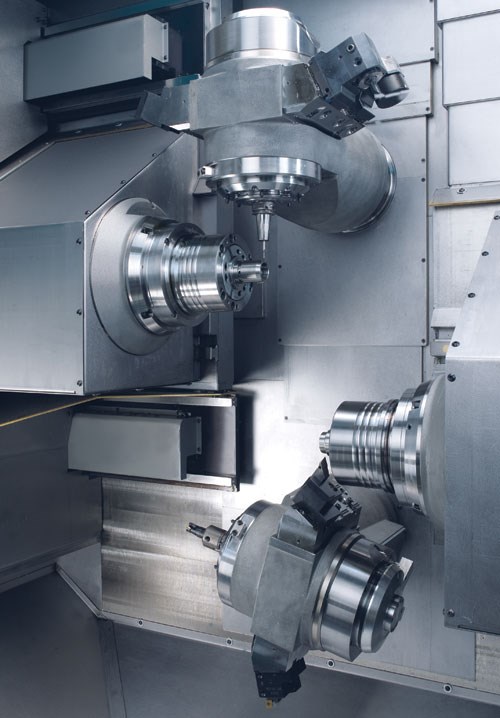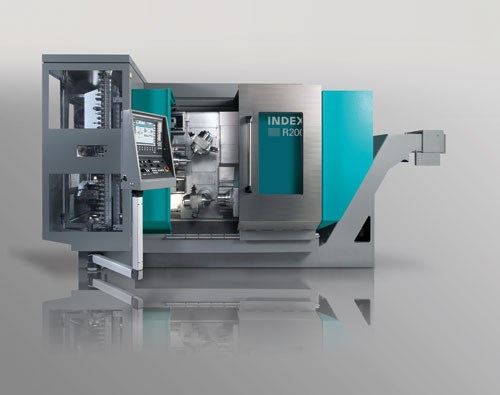A New Breed Of Turn-Mill Center
The turn-mill center continues to evolve its capabilities. This new machine from Index is an example.
Dropping parts complete in one chucking is the goal of most progressive precision machine shops. And there has been a steady parade of capable machine tools to help meet that goal. But a new step has been taken by Index Corp. with its energy efficient R200 turn-mill center.
Officially introduced in Germany only weeks ago, several shops in the United States have already decided that the R200 is a machine for their future.
The idea: a machine design in which the main horizontal 65-mm spindle moves in Z (390 mm), the 65 mm subspindle moves in X (600 mm) and Z (390 mm), the milling spindle No. 1 (top) moves in XYB, and milling spindle No. 2 (bottom) moves in YB.
The result: a design with two, five-axis independent subsystems, exceptional stiffness and impressive dynamic response. Workpieces can be machined efficiently and in parallel on both front and reverse sides within the open work area. In each of the two subsystems, a 22-hp motorized milling spindle and a 44-hp work spindle are assigned to one another. All of this capability, not including bar feeder, is contained within only 6 square meters of floor space.
Two linear tool carriers mounted to the side of each milling spindle allow quick access to six stationary turning tools for each milling spindle. Additionally, two separate shuttle units independently load the two motorized milling spindles with HSK-A40 tools from a common chain tool magazine with either 80 or 120 tool positions. The tool set in the magazine can be used by both tool carriers without restriction.
According to the company’s engineers, the design of the R200 allows it to machine equivalent workpieces almost twice as fast as commercially available turn-mill centers that use only a motorized milling spindle. Both heavy-duty roughing operations and highly accurate fine-turning operations can be performed simultaneously on the 5,000-rpm, peak torque of 150 Nm, main spindle and subspindle.
The machine design allows for highly productive, flexible machining operations on a range of materials, up to and including simultaneous and independent five-axis machining on each spindle. What used to require a turning machine (or conventional turn-mill) and a machining center can now be completed in a single operation.
Designed for Stability
During development, emphasis was placed on achieving a high degree of thermal stability and vibration damping to enable simultaneous machining of difficult-to-cut and high-strength materials.
The design and arrangement of proven mechanical components provide for maximum stiffness and minimum vibration as well as for optimum thermal and dynamic stability. The basis for this is the vertical cast machine bed with a heavily ribbed, enclosed modular design. The axis arrangement produces directional kinematics, which in turn, enables the R200 to accomplish complete machining of many complex parts.
The two quill-guided 18,000-rpm motorized milling spindles were placed in the center of the machine bed and move freely in the Y and B axes—wear-free—via hydrostatic circular guides. The guide system contributes significantly to the high degree of stiffness of the machine and is the heart of this new system. Its diagonal arrangement allows the usual cross-slide to be omitted, and an overall system with exceptional stiffness is the result.
According to Index, benefits resulting from the enclosed modular concept and hydrostatic circular guide in the design include better workpiece quality, extended tool life, higher rapid traverse rates and accelerations, and generally, improved machining performance.
Optimum force transmission was a key design requirement. Because it uses very short lever arms, the kinematically efficient axis arrangement is less vulnerable to vibrations, which in turn, has a positive effect on the accuracy of the finished parts and on tool life.
Other pluses are the high accelerations and rapid traverse rates—at which the machine axes can be moved—aided by powerful drives and weight-optimized assemblies. Key work spindle data, such as 0.9-second ramp-up time (0 to 5,000 rpm), make possible the high-performance machining operations.
The flexibility and speed of the machine are due in part to the B-axis swivel ranges of 270 and 230 degrees and the rapid traverse rate of 45 m/min. With a 190-mm quill diameter, the upper tool carrier travels 350 mm in the X axis and about 80 mm in the Y axis; the lower tool carrier also travels about 80 mm in the Y axis.
At the base of the running tools, the company’s W-serration minimizes the associated setup effort and ensures a force-locking and form-locking tool fit, essential for precise turning operations. With a fit comparable with that of a turret, the W-serration has been a major contributor to longer tool life on other Index machines.
Minimum Chip-to-Chip Times
The R200 features very short chip-to-chip times of approximately 4 seconds, contributing significantly to the minimization of overall processing times. While machining is performed on the main spindle, the lower milling spindle can load a new tool, protected from falling chips and coolant. This also contributes to high productivity and improves process reliability.
Workpiece Removal
An integrated gantry-type removal unit with
100 m/min traverse enables fast handling of workpieces as large as 200 mm without damage. Finished parts are placed on a conveyor belt and bar remnants in a separate remnant container.
New SBL Bar Loading Magazine
Barstock is fed by a material guide channel mounted to be moveable in the Z direction and permanently connected to the main spindle. The sliding bar loader is designed for barstock of 20-mm to 65-mm diameter and lengths to 3,000 mm. Material can end-stop in about 1.5 seconds. A reserve magazine of as many as six bars supports unmanned operation of the machine.
CNC Designed for the User
The Index C200-4D SL control is based on the Siemens S840D Solution Line and has been enhanced with user-friendly functions for the R200. Specially developed cycles can simplify the most complex machining operations. They support multi-axis milling and turning operations and provide functional reliability.
Numerous control functions support user requirements during manufacturing and provide for efficient and economical production, including direct access to wear compensations, adapter transformation for all tool stations, plain-text error display, online access to diagnostics manual via the control and an optional tool breakage monitor.
Virtual Machine Programming
The company’s VirtualLine software packages support economical use of the turn-mill center from the very first workpiece. Ideally coordinated with one another, these packages complement each other in terms of their functions and intuitively guide the NC programmer and operator to the right solution for the machining task, both on the PC during the preparation stage and directly at the machine on the shop floor.
The software lets users simulate part programs as they would run on the actual machine without any risk, maximizing production on the machine tool and keeping programming offline. The identical user software mirrors the real configuration data so users can program, set up and operate the “virtual machine” in exactly the same way as the real machine.
The CNC programming studio provides additional advanced support for programming and operating the R200. A number of powerful user cycles permit field-oriented applications, tested operation of functions, flexibility, short machining times and optimum machine use.
The Index virtual machine, which contains a copy of the Siemens CNC kernel of the S840D control and which can carry out a 3D machine modeling down to the last detail in the simulation system, directly executes the CNC program.
This guarantees that workpiece machining and program execution will occur exactly as on the machine and allows existing CNC programs to be edited without having to recreate another adaptation. All of this takes place off-machine so users can avoid any loss of production time. This also eliminates risk of collisions or damage to the machine. Everything on the virtual machine screen is a 1 to 1 ratio—exactly how it is on the machine itself.
As machines become more complicated, automated programming and accurate simulation are critical for saving setup time, the company says, potentially as much as 50 to 75 percent, because users do not have to tool the machine to achieve a setup, and they can see if the tools are interfering. Machine time is expensive, and if users can save 50 percent setup time, they can get that much more production 24 hours a day.
This new machine tool takes precision part production a big step further regarding the complexity of the parts it can process in a single operation and reducing the cost to produce those parts through quicker processing and reduced energy use. It may be a new benchmark for single-platform precision metalcutting systems.
Related Content
Shop Optimizes its Swiss-Turning Flexibility
Paramount Machine uses various Swiss-type lathes, some with a B axis, to produce parts more effectively than it did on conventional chucker lathes. Today, nearly every job under 1.5 inches in diameter runs across those machines even if the batch size is a mere 5 pieces.
Read MoreShop Sets its Sights on Precise Tool Alignment
A Wisconsin shop has found that visual tool alignment technology has improved tool life and surface finishes for its Swiss-type lathes while increasing throughput as well.
Read MoreVideo: Why a Production Machine Shop Started a Baseball Bat Company
A 153-year-old manufacturer of precision, metal pins recently started a side business creating custom wooden baseball bats. The reasoning behind establishing this new company is intriguing, as is how it has helped create a stronger bond with the local community.
Read MoreGetting More Production From Swiss Turning Centers
Buying a new CNC Swiss turning center is a substantial investment. For the best return, look closely for capabilities that enable the best utilization of the machine.
Read MoreRead Next
5 Aspects of PMTS I Appreciate
The three-day edition of the 2025 Precision Machining Technology Show kicks off at the start of April. I’ll be there, and here are some reasons why.
Read MoreSeeing Automated Workpiece Measurement in Real Time
User-friendly inspection software for CNC machining centers was shown at IMTS 2024 monitoring measurements between and after machining while performing SPC based on recorded measurement values.
Read MoreA Tooling Workshop Worth a Visit
Marubeni Citizen-Cincom’s tooling and accessory workshop offers a chance to learn more about ancillary devices that can boost machining efficiency and capability.
Read More


























